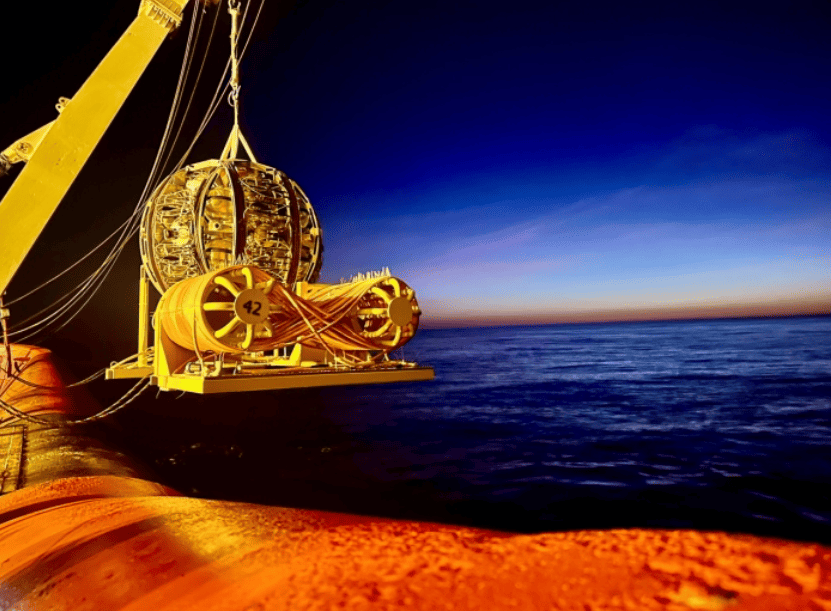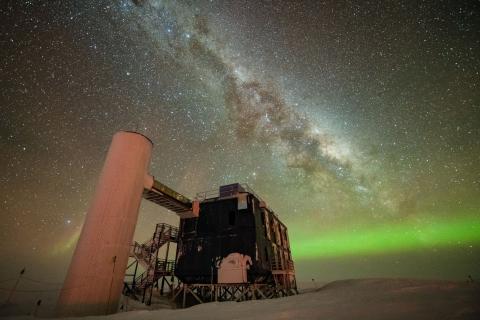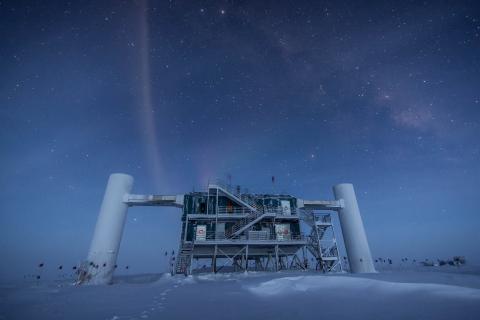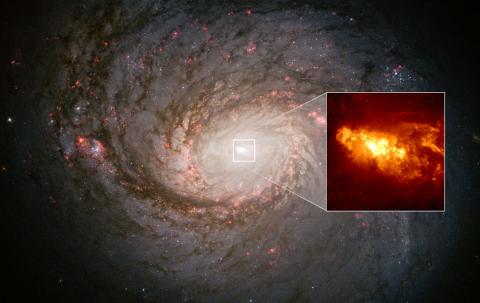Highest-energy cosmic neutrino detected to date
An international team of scientists from the KM3NeT collaboration has detected the signal from the highest-energy cosmic neutrino to date, some 30 times higher than those previously detected. The result suggests that the particle came from beyond the Milky Way, although its precise origin has yet to be determined. The results are published in the journal Nature.

Valentina - Neutrino (EN)
KM3NeT [a European underwater research infrastructure] has succeeded in detecting a very high-energy event, called KM3-230213A, associated with cosmic neutrinos.
The KM3NeT underwater telescope is located deep in the Mediterranean and consists of two modes: the ARCA detector, near Sicily (Italy), mainly focused on neutrino astronomy and the ORCA detector, near the French Mediterranean coast, optimized for the study of atmospheric neutrino oscillations. Both detectors have not yet been completed but are now operational. Once completed, the KM3NET telescope will reach proportions on the order of a cubic kilometer.
When a high-energy neutrino interacts in the vicinity of the detector, it creates charged particles that emit luminous radiation.
Even with its detectors still under construction, KM3NeT/ARCA has managed to observe the signal from a muon (a charged particle, similar to the electron but heavier) of very high energy, on the order of ~120 PeV (peta-electronvolts). In view of its enormous energy and nearly horizontal direction, this signal seems to be associated with a neutrino of cosmic origin, with an estimated energy of ~220 PeV.
With this result, the KM3NeT collaboration reports evidence of the observation of the highest energy cosmic neutrino detected to date. This is an extremely important result that confirms the absolutely relevant role of neutrino telescopes in multi-messenger astronomy. Previously, another telescope (IceCube, located at the South Pole) had announced the observation of PeV neutrinos, but (more than) 10 times less energetic than KM3-230213A. Note also the complementarity between the two experiments, KM3NeT and IceCube, each mostly sensitive to neutrinos coming from different directions of the sky.
The KM3NeT study is of high quality and suggests that the neutrino may have originated from a cosmic accelerator different from those that originate the lowest energy cosmic neutrinos. Alternatively, this could be the first detection of a cosmogenic neutrino, i.e., resulting from interactions of ultrahigh-energy cosmic rays with cosmic background photons in the universe. The most likely extragalactic neutrino sources for the KM3-230213A event should be active galactic nuclei and blazars (bright nuclei of active galaxies). Researchers have identified some blazar sources that could be compatible with the estimated direction from which the neutrino traveled; however, so far, none of them has been clearly identified as the astrophysical source of the neutrino.
Other possible origins, for example, related to new physics, such as a very massive dark matter candidate, are also not ruled out.
It is clear that this result is a major breakthrough in neutrino astronomy, as it provides evidence for the existence of ultra-high energy neutrinos in nature, at previously unexplored energies.
On the other hand, it opens new questions about their origin. Further investigation and future observations will allow us to better understand the physical mechanisms that give rise to very high-energy neutrinos.
Mariam - Neutrino k (EN)
Mariam Tórtola
Senior Lecturer in the Department of Theoretical Physics at the University of Valencia and at the Institute of Corpuscular Physics (IFIC)
With only 10% of its final size in operation, the KM3NeT/ARCA experiment has detected the most energetic neutrino observed to date, with an energy 30 times higher than that of neutrinos previously recorded by the IceCube neutrino telescope at the South Pole.
The article published by the international collaboration KM3NeT contains a rigorous study, which analyzes in depth the main properties of the detected event, such as its energy and direction of arrival, as well as the possible origin of the neutrino that triggers the observed signal.
To date, neutrinos of such high energies have not been observed, which suggests that this type of neutrino is not very abundant. This work analyzes the coherence of the detected signal with the absence of detections in other experiments, such as the neutrino telescopes IceCube (located at the South Pole) and ANTARES (predecessor of KM3NeT) or the Pierre Auger cosmic ray detector (in Argentina). According to these previous results, one would expect to observe only one event such as the one recorded in 70 years of operation of the KM3NeT experiment. Even so, it is estimated that the observed signal would be a statistical fluctuation compatible with the previous results. This observation is, therefore, the first evidence of the existence of neutrinos with extremely high energies in nature.
In addition to its energy, another crucial aspect addressed by this study is the origin of the observed signal. According to the analysis presented, it is unlikely to have been generated by a muon or an atmospheric neutrino, which points to a possible cosmic origin. In such a case, it could be a cosmic neutrino coming from an astrophysical accelerator, such as an active galactic nucleus (AGN), or a cosmogenic neutrino, produced in the interaction of cosmic rays with the photons of the cosmic microwave background. The latter type of neutrino has not yet been detected, which highlights the relevance of the observation made.
The main limitation of this work lies in the difficulty of identifying the origin of the signal, especially when only one neutrino is available. The search in different catalogs has not revealed any transient source coincident with the event, but it has allowed us to identify up to 12 blazars (a type of AGN) in its vicinity, which could be the origin of the emission. However, for the time being, this result is not conclusive. The full installation of KM3NeT/ARCA will significantly increase the detector's sensitivity to very high energy events, thus improving its ability to identify the sources of these cosmic neutrinos.
Pobes - Neutrino k (EN)
Carlos Pobes
Postdoctoral researcher of the Q-MAD group at the Institute of Nanoscience and Materials of Aragon (INMA)
The recent outcome of the KM3NeT collaboration is certainly surprising. It is exciting, but it is so exceptional that it forces us to be cautious. There are several explanations for such an extraordinary event, and all of them have a low a priori probability.
The most natural explanation (that it is the first neutrino of cosmogenic origin, the well-known GZK background) clashes with the difficulty that IceCube (the other operational neutrino telescope) has not detected any event. The article itself discusses this possibility, which would have a probability of about 1 % (one must think that IceCube currently has a volume 10 times larger and has been taking data for 10 times longer).
Another possibility is that it is an astrophysical source [which would arrive in a punctual way and not uniformly and from all directions, as would the one we call cosmogenic], but of the possible candidates identified, no anomalous activity has been observed in any of them with other instruments.
One last possibility remains. The collaboration has made a very rigorous analysis of the data and in fact has taken 2 years to publish the result, but the energy value assigned to this event is an estimate that depends on many intermediate processes, each of them affected by certain uncertainties. It is possible that they have all 'aligned' to produce an abnormally high signal even though the original neutrino was of significantly lower energy and therefore less exceptional.
In any case, the solution to the enigma lies in accumulating more data, particularly once KM3NeT reaches its final size. It should be noted that IceCube itself is starting campaigns to expand its volume as well, so hopefully we will have an answer to this problem in the remainder of the decade. Of course, these are exciting times for astrophysics and cosmology; we are living live the birth of a new way of looking at the universe, and this event confirms that KM3NeT is already a reality. My sincere congratulations to the collaboration.
Conflict of interest: "I am not currently involved with any of the research or collaborations. In the past I was winter over of the IceCube experiment for one year."
The KM3NeT Collaboration.
- Research article
- Peer reviewed



